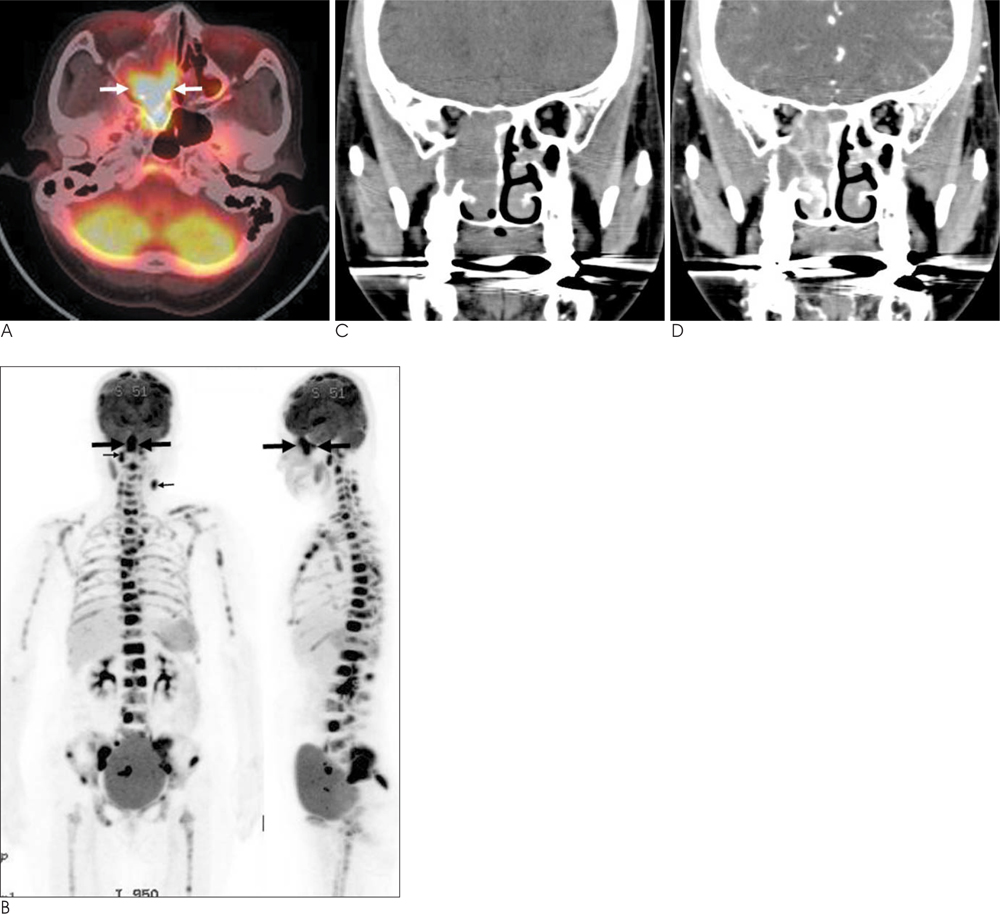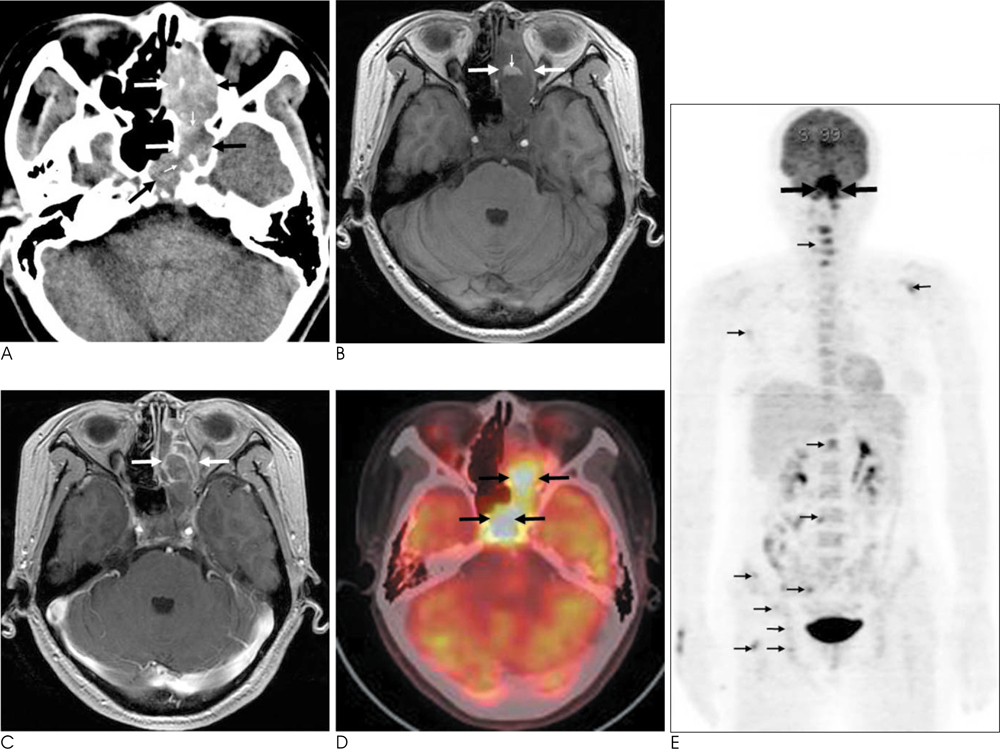J Korean Soc Radiol.
2011 Feb;64(2):117-121. 10.3348/jksr.2011.64.2.117.
The CT and MR Imaging Findings of Adulthood Sinonasal Alveolar Rhabdomyosarcoma with Disseminated Metastases on 18F-FDG PET/CT: Report of Two Cases
- Affiliations
-
- 1Department of Radiology, Dongsan Medical Center, Keimyung University School of Medicine, Daegu, Korea. sklee@dsmc.or.kr
- KMID: 2097926
- DOI: http://doi.org/10.3348/jksr.2011.64.2.117
Abstract
- We report herein two cases of adulthood sinonasal alveolar rhabdomyosarcoma that showed intense hypermetabolism and disseminated metastasis on 18F-FDG PET/CT. The contrast-enhanced CT (CECT) and gadolinium-enhanced T1-weighted images (Gd-T1WI) showed multiple rings of intense enhancement (the "botryoid sign") of the mass. Adulthood rhabdomyosarcoma should be considered when a sinonasal mass shows the "botryoid sign" on CECT or Gd-T1WI, and intense hypermetabolism with disseminated metastases on 18F-FDG PET/CT.
MeSH Terms
Figure
Reference
-
1. Feldman BA. Rhabdomyosarcoma of the head and neck. Laryngoscope. 1982; 92:424–440.2. La Quaglia MP, Heller G, Ghavimi F, Casper ES, Vlamis V, Hajdu S, et al. The effect of age at diagnosis on outcome in rhabdomyosarcoma. Cancer. 1994; 73:109–117.3. Tateishi U, Hosono A, Makimoto A, Nakamoto Y, Kaneta T, Fukuda H, et al. Comparative study of FDG PET/CT and conventional imaging in the staging of rhabdomyosarcoma. Ann Nucl Med. 2009; 23:155–161.4. Klem ML, Grewal RK, Wexler LH, Schöder H, Meyers PA, Wolden SL. PET for staging in rhabdomyosarcoma: an evaluation of PET as an adjunct to current staging tools. J Pediatr Hematol Oncol. 2007; 29:9–14.5. Peng F, Rabkin G, Muzik O. Use of 2-deoxy-2-[F-18]-fluoro-D-glucose positron emission tomography to monitor therapeutic response by rhabdomyosarcoma in children: report of a retrospective case study. Clin Nucl Med. 2006; 31:394–397.6. Iagaru A, Goris ML. Rhabdomyosarcoma diffusely metastatic to the bone marrow: suspicious findings on 99mTc-MDP bone scintigraphy confirmed by (18)F-18 FDG PET/CT and bone marrow biopsy. Eur J Nucl Med Mol Imaging. 2008; 35:1746.7. Seshadri N, Wright P, Balan KK. Rhabdomyosarcoma with widespread bone marrow infiltration: beneficial management role of F-18 FDG PET. Clin Nucl Med. 2007; 32:787–789.8. Hagiwara A, Inoue Y, Nakayama T, Yamato K, Nemoto Y, Shakudo M, et al. The "botryoid sign": a characteristic feature of rhabdomyosarcomas in the head and neck. Neuroradiology. 2001; 43:331–335.9. Enzinger FM, Weiss SW. Soft tissue tumors. 3rd ed. St Louis: Mosby;1995. p. 539–577.10. Ihara T, Okamura D, Takahashi N, Kohri M, Kayano H, Tamaru J, et al. Alveolar rhabdomyosarcoma mimicking nasal lymphoma at the initial presentation. J Clin Exp Hematop. 2008; 48:61–64.
- Full Text Links
- Actions
-
Cited
- CITED
-
- Close
- Share
- Similar articles
-
- Use of 18F-FDG PET/CT in Second Primary Cancer
- Metastases to Skeletal Muscles from Non-Small Cell Lung Cancer Demonstrated by 18F-FDG PET/CT
- Lung Adenocarcinoma Staged as an Unknown Primary Presenting with Symptomatic Colon Metastases: Staging by 18F-FDG PET/CT
- Orbital Metastases as Presenting Sign of Lung Carcinoma: Detection of Primary Malignancy and Disease Burden by F-18 FDG PET/CT
- Esophageal Leiomyoma with intense FDG uptake on 18F-FDG PET/CT



